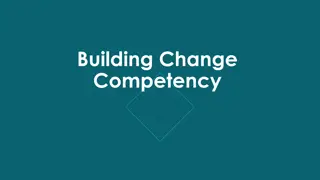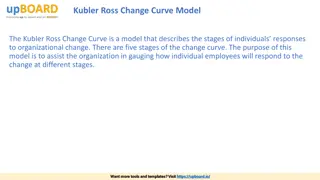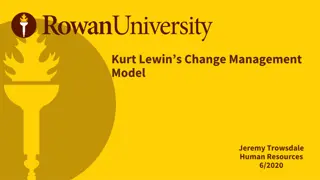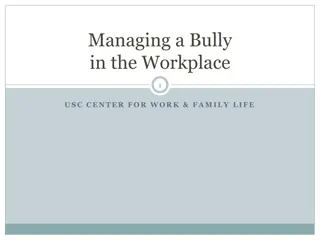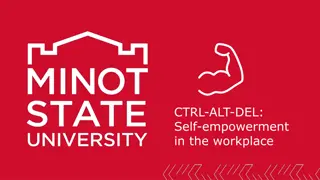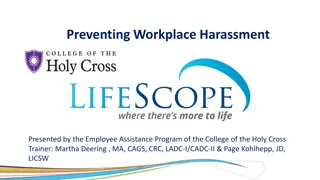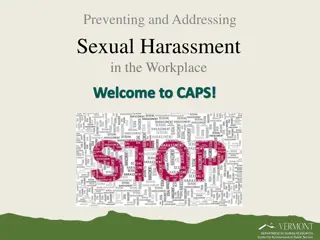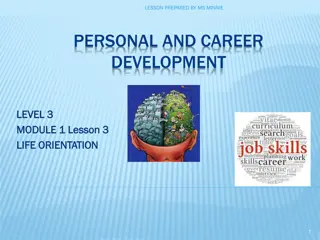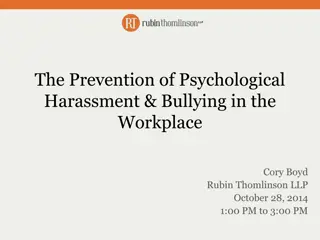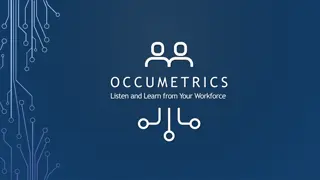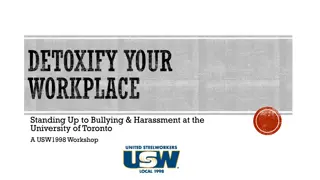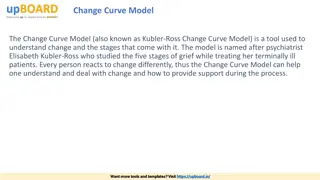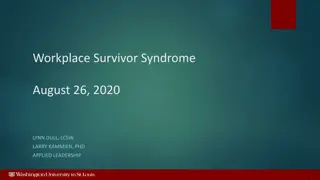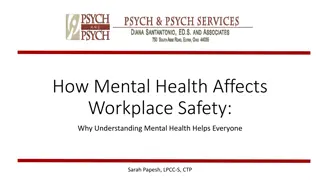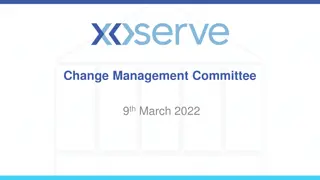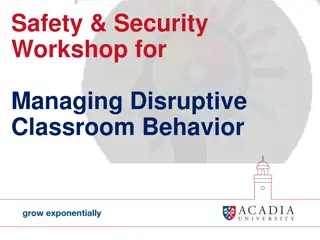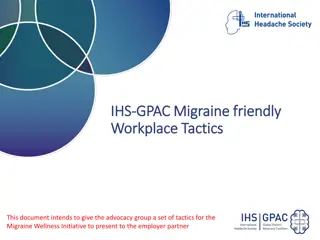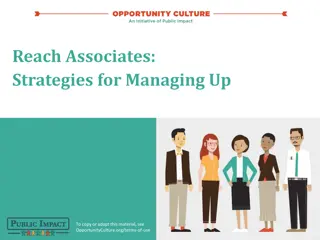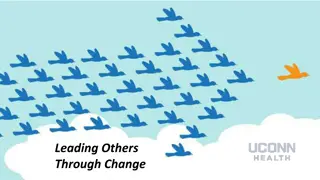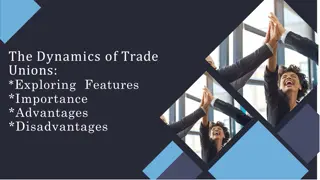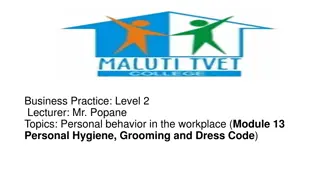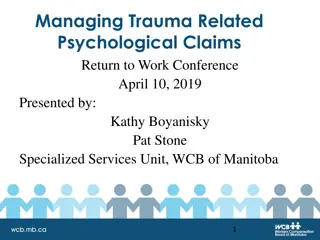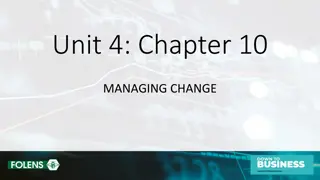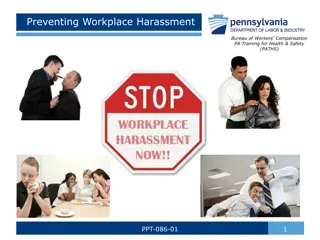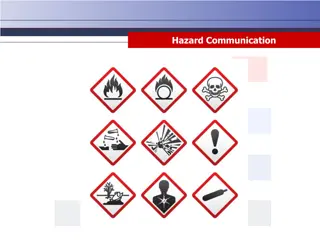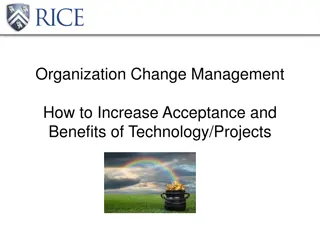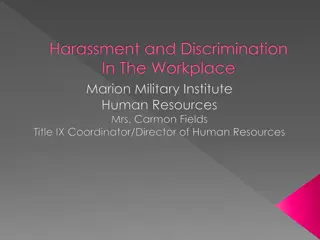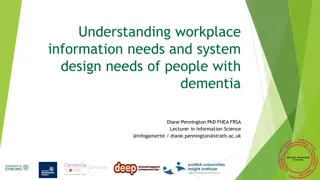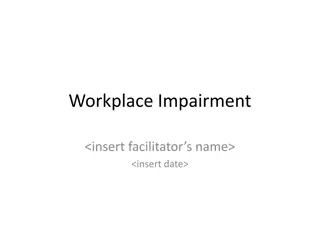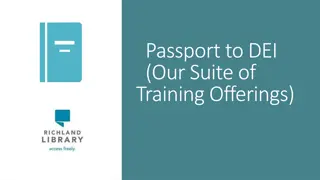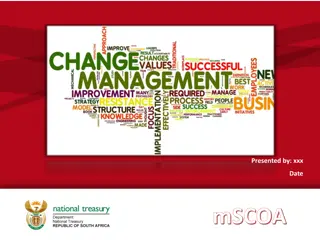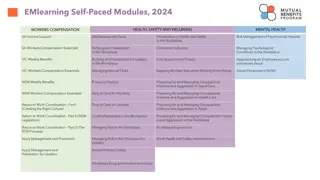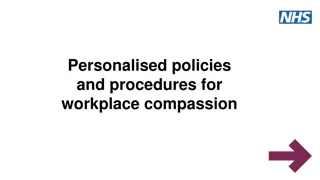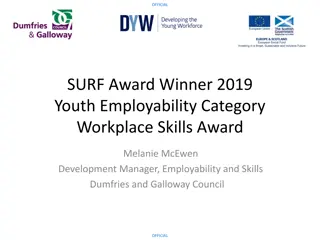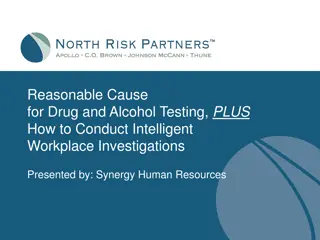Understanding and Managing Change in the Workplace
Explore the process of change and transition, with insights on employee reactions, tools for coping, and examples of positive and negative changes. Learn to navigate the emotional aspects of transition to adapt effectively to workplace changes.
Download Presentation

Please find below an Image/Link to download the presentation.
The content on the website is provided AS IS for your information and personal use only. It may not be sold, licensed, or shared on other websites without obtaining consent from the author. Download presentation by click this link. If you encounter any issues during the download, it is possible that the publisher has removed the file from their server.
E N D
Presentation Transcript
Managing Change: Making the Most out of Change March 28, 2018 Bob Norton, CEAP, LPC
NIST Employee Assistance Program Bob Norton 301-975-5129 101/C33 Services Free Short term counseling, consultation, assessment and referral on work related and personal concerns Management Consultation Training Grief Counseling and Trauma Response Stress management Family/Marital Emotional Elder Care and other dependent care issues Alcohol and Drug counseling/assessment Legal/Financial resources Hallmarks Confidential Short Term Counseling and Consultation for all who work at NIST and their immediate family members. Training Communication Change Management Anger Management Conflict Resolution Stress Management Myers-Briggs Training Working with Difficult People Humor in the Workplace Workplace Violence Prevention Civility in the Workplace Confidentiality Informed consent Written Release to disclose Security Voluntary
Managing Change 15% of the workforce is eager to accept it 15% of the workforce is dead set against it 70% is sitting on the fence, waiting to see what happens 6% Propose change 7% Buy-in quickly 32% Join in after some success 42% Join in after risk is zero 13% Continue to oppose
Objectives Learn the difference between change and transition Learn about the developmental model of transition (Ending, Neutral Zone, New Beginnings Understand the potential of the Neutral Zone Understand the impact of change/transition Self/family/management/organization Learn about useful tools to navigate the emotional side of transition in adapting to change Learn useful coping tools in managing transitions
Managing Change What is change? Change is an event expected or unexpected. It takes place in a particular point in time. Something stops and something new happens What is transition? Transition is the gradual psychological process through which individuals/groups reorient/adjust to a new situation. Transition cannot be localized in time.
Change Can Be Perceived As Positive or Negative Getting a Job After Graduating From College Getting Married Divorce Having a Child Child Leaving for College Child getting married Getting a new job Losing a Job Death of a Parent Reorganization
Activity Reflect on a major change in your life: 1. As you made this change in your life, what ended? security, turf, status, influence, memberships, meaningful work, identity, control, relationships, etc. How did that make you feel? 2. angry, scared, lonely, excited, relieved, wondering What helped (or might have helped) to make the transition easier? 3. (talk to someone, time, information, knowing others were going through the same thing, ) What did you learn to avoid in the future? 4. What kind of outcome did you have? What helped create a good outcome? 5. What would you do differently to avoid a bad outcome?
Stages of Transition Begins with an Ending Has a Neutral Zone Has a New Beginning
Three Phases of Transition *People transition at different paces NEUTRAL ZONE NEW ENDINGS BEGINNINGS Not yet begun Finished Time
Managing Change Begins with an Ending Shock/Denial/Disbelief/Minimization Defensive retreat/Anger/Rage/Fear Resistance Acknowledgement Acceptance/Integration
Letting Go Strategies How to Let go Accept reality of subjective losses Don t be surprised at overreaction (normal) Acknowledge the losses openly Expect signs of loss/mark the endings Give and request clear information (again and again and again) Treat the past with respect It was the past that got you here Embrace risk taking, innovation, and learning from experiences/mistakes Know your resources He who lacks the time to mourn lacks the time to heal. Every exit is an entry to somewhere else.
Managing Change Factors in Organizational Change People (They are essential change agents) Resistance is a natural and inevitable reaction in an organization. You can expect it Resistance is sometimes hidden, so it may be necessary to take active steps to find it There are many reasons for resistance; it is important to understand it We manage resistance by working with people, and helping them deal with their concerns There are many ways to build acceptance. It is important to be flexible. But persist!
Resistance to Change Why people resist change: Defense mechanism caused by frustration and anxiety A potential loss of status, pay, comfort, or power that arises from expertise A fear of the unknown future and about their ability to adapt to it, e.g. fear that one will not be able to develop new skills and behaviors that are required in a new work setting Resentment in employees due to a perceived unfairness of the change Possible violation of "personal agreements" management has with their employees. This can involve elements of mutual trust, loyalty and commitment and go very deep An employee may be operating on the basis of a desire to protect what they feel is in the best interests of the organization An employee may provoke insightful and well-intended debate, criticism, or disagreement in order to produce better understanding as well as additional options and solutions
Managing Change Resistance to Change The take-home message: there is no simple explanation for Resistance to Change, and therefore no simple way to circumvent it. There are instances where an employees resistance , although not in the plan, could result in beneficial consequences
Managing Change The Neutral Zone
Managing Change Neutral Zone Loss of focus Confusion People leaving Uncertainty (what next?) Ambiguity Lack of communication Loss of trust Rumors run rampant Stress increases Lack of direction Decrease in productivity Fertile void (for good or bad)
Managing Change Where to start: The 4 Ps Purpose Make the case explain the rationale in straight forward terms Adults want an honest explanation Picture What will it look like (helps with explanation) What s in it for them (helps with engagement) Plan Involve employees in the planning (seek expertise) Participation Involve all the stakeholders Relationships (Build or Re-build both ways) William Bridges Managing Transitions
Managing Change New Beginnings (Reorganization of Behavior) New Vision New Plans New Energy
Managing Change Progress with New Beginnings Endorse New Beginnings by: Walking the walk : be consistent Be aware of quick successes Symbolize the new identity Celebrate the success (large and small) Embrace the setbacks as opportunities Communicate, Communicate, Communicate (to and from management) Listen, Listen, Listen
Impact on Managers Perspective Managers deal with the stress of change Unknowns loss worry Managers have to lead and guide employees through transition (energy consuming) Managers (also employees) need to be aware of the impact and upheaval change can have on employees Managers need to be present (available). MBWA
What Does it Take? Communication Knowing what you want Being Proactive Knowing your audience Being open & honest Communication Remaining focused Being flexible Communication
What You Can Do Acknowledge change Acknowledge feelings Accept feelings Seek support Allow time to grieve the loss Designate worry time Communicate (obtain accurate, factual information) Stay Positive Learn about transition Be flexible Attitude of learning Participate (input/plan) Manage stress Exercise/relaxation/diet Increase your value Keep working Measure and celebrate success
Managing Change How to Relieve/Manage your Stress Recall useful past experiences Control responses Be proactive/Stay engaged! Stay informed Take care of yourself Recognize needs and ask for help Talk it out Practice stress management Exercise Good nutrition Avoid complainers Seek out optimists Avoid isolating Save or Make time for leisure activities CONSIDER OPTIONS NETWORK Update resume Career transition assistance Remember the value of Humor Resources
Best Practices Sr. leadership plays vital role (be present) Over-communication is impossible during change Planning begins with getting the right people together Information not normally required for day-day ops is critical during change Development of a transition plan from all sides Enlists stakeholders participation I.D. of business processes no longer needed in future is vital to success Goal setting strategies Provision of career transition Monitoring and recognizing progress (Quick wins)
Consequences of not Managing Change Lower productivity Passive resistance Active resistance Turnover of valued employees Disinterest in the current or future state Arguing about the need for change More sick days Change not fully implemented People finding work arounds People revert to the old way of doing things The change being totally scrapped Divides are created between us and them
Summary Change is an event followed by transition a process of adjustment involving letting go, a neutral zone and embracing new beginnings. Transition to change is influenced by attitudes, beliefs and experiences and has an emotional impact on those affected. The Neutral Zone there is great potential for both positive and negative paths. Continuous communication of facts is imperative in successful navigation of change events. Employment of stress management (exercise, diet, sleep, social contacts) can enhance transition process.
SooooDepending on your outlook; Change can be: Painful Threatening Uncertain Necessary Beyond control Unfair OR . Change can also be: Opportunistic Exciting Rewarding Challenging Healthy Hopeful


